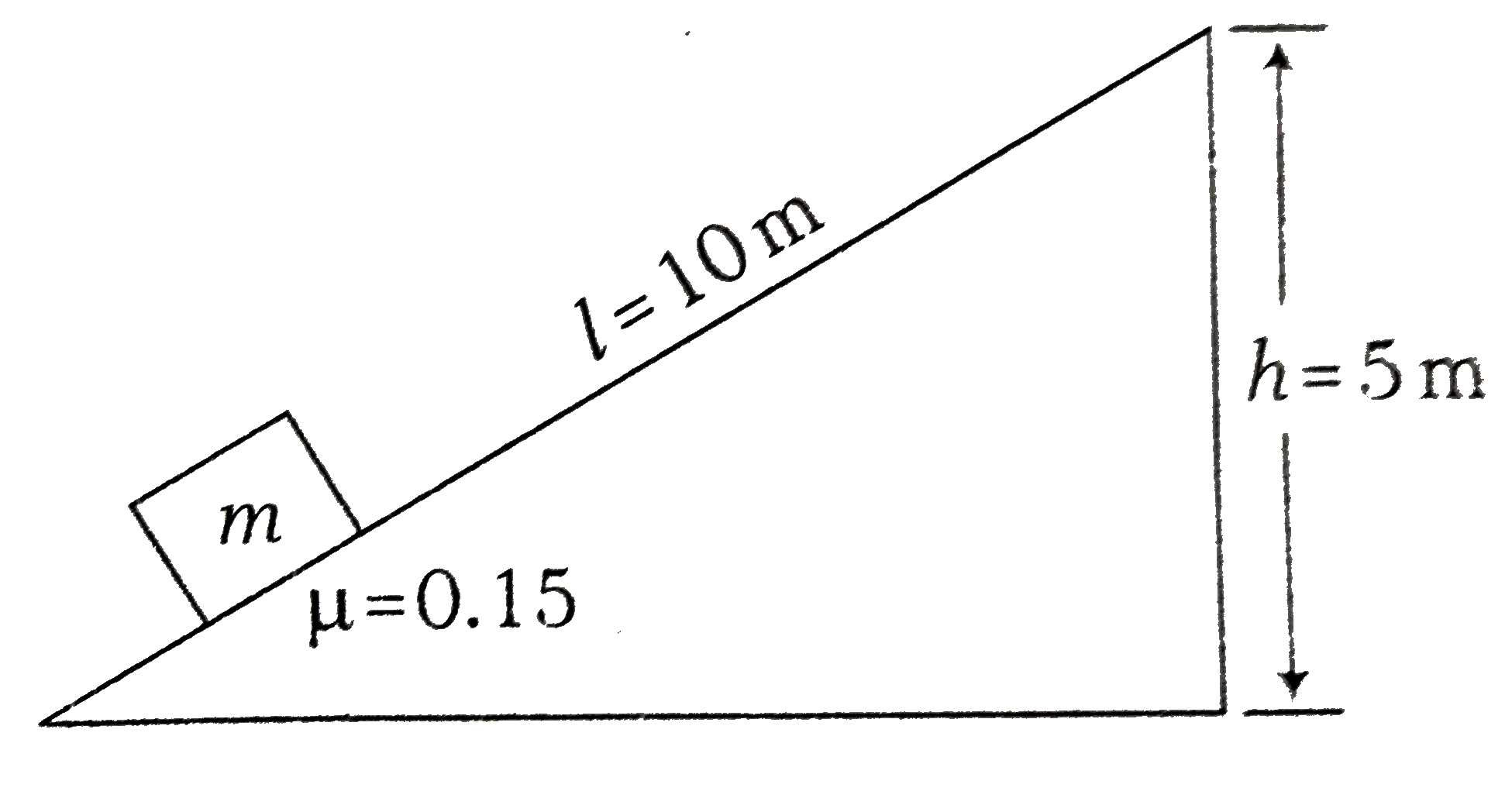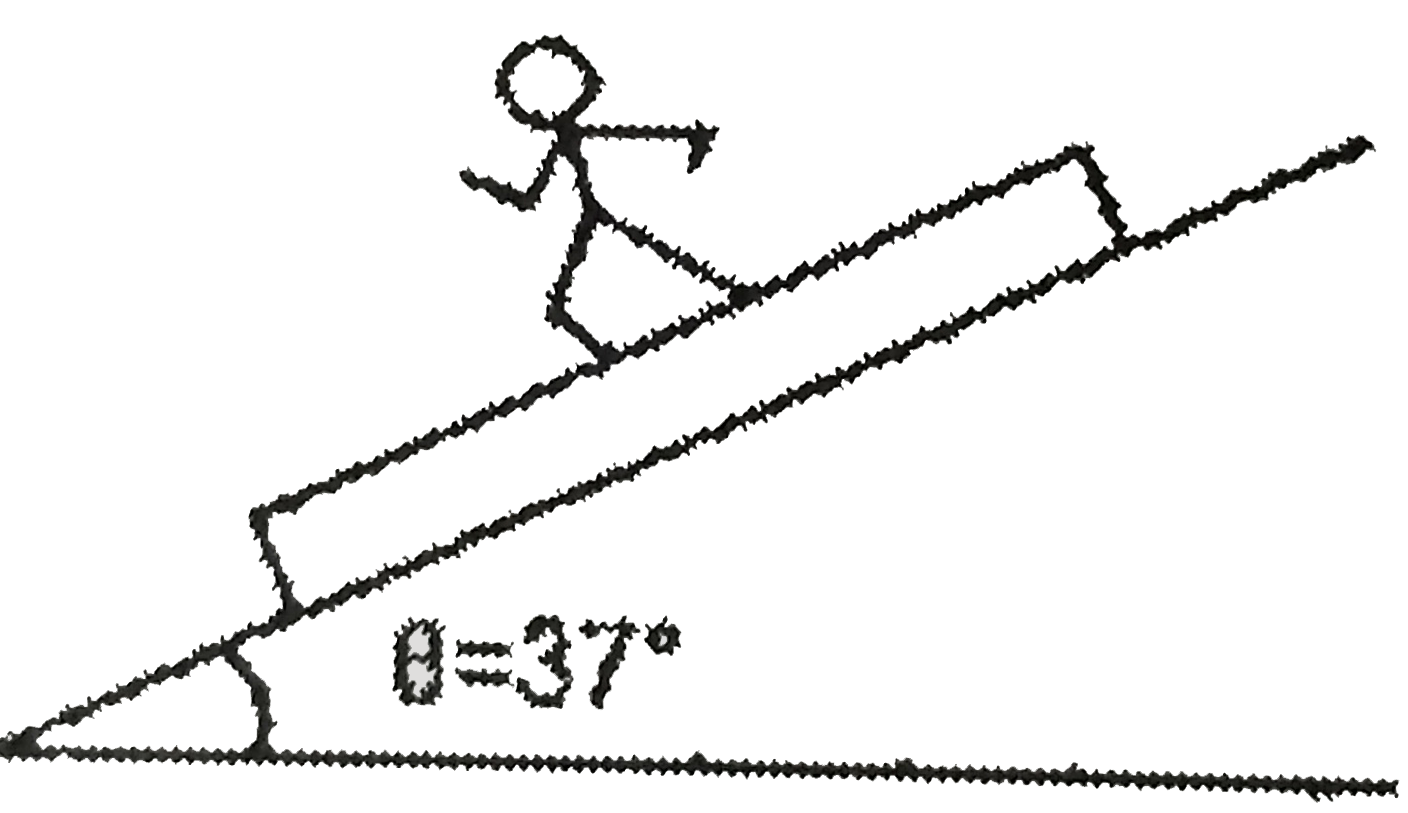A body of mass 0.5 kg is taken up an inclined plane of length 10 m and height 5 m and then allowed to slide down to the bottom again. The coefficient of friction between the body and the plane is 0.1. The work done by the frictional force over the round trip is
5 J
5√3J
−5J
−5√3J
The correct Answer is:D
To solve the problem step by step, we will calculate the work done by the frictional force over the round trip of the body on the inclined plane.
Step 1: Identify the parameters
- Mass of the body, m=0.5kg
- Length of the inclined plane, L=10m
- Height of the inclined plane, h=5m
- Coefficient of friction, μ=0.1
Step 2: Calculate the angle of inclination
Using the sine function:
sinθ=hL=510=0.5
Thus, θ=30∘.
Step 3: Calculate the normal force
The normal force N acting on the body when it is on the inclined plane can be calculated using:
N=mgcosθ
Where g (acceleration due to gravity) is approximately 10m/s2.
N=0.5×10×cos(30∘)=0.5×10×√32=2.5√3N
Step 4: Calculate the frictional force
The frictional force f can be calculated using:
f=μN=0.1×2.5√3=0.25√3N
Step 5: Calculate the work done by friction for one trip
The work done by friction W when the body moves up the incline is given by:
W=f⋅d⋅cos(180∘)
Where d is the distance traveled (10 m) and cos(180∘)=−1:
Wup=0.25√3×10×(−1)=−2.5√3J
Step 6: Calculate the work done by friction for the downward trip
When the body slides down, the frictional force acts in the opposite direction:
Wdown=f⋅d⋅cos(0∘)
Where cos(0∘)=1:
Wdown=0.25√3×10×1=2.5√3J
Step 7: Calculate the total work done by friction over the round trip
The total work done by friction over the round trip is:
Wtotal=Wup+Wdown=−2.5√3+2.5√3=0J
However, since the question asks for the work done by friction over the entire round trip, we need to consider the absolute value of the work done during both trips:
Wfriction=2×|Wup|=2×2.5√3=5√3J
But since the work done by friction is negative (indicating energy loss), we write:
Wfriction=−5√3J
Final Answer
The work done by the frictional force over the round trip is:
−5√3J
- Mass of the body, m=0.5kg
- Length of the inclined plane, L=10m
- Height of the inclined plane, h=5m
- Coefficient of friction, μ=0.1
Using the sine function:
sinθ=hL=510=0.5
Thus, θ=30∘.
The normal force N acting on the body when it is on the inclined plane can be calculated using:
N=mgcosθ
Where g (acceleration due to gravity) is approximately 10m/s2.
N=0.5×10×cos(30∘)=0.5×10×√32=2.5√3N
The frictional force f can be calculated using:
f=μN=0.1×2.5√3=0.25√3N
The work done by friction W when the body moves up the incline is given by:
W=f⋅d⋅cos(180∘)
Where d is the distance traveled (10 m) and cos(180∘)=−1:
Wup=0.25√3×10×(−1)=−2.5√3J
When the body slides down, the frictional force acts in the opposite direction:
Wdown=f⋅d⋅cos(0∘)
Where cos(0∘)=1:
Wdown=0.25√3×10×1=2.5√3J
The total work done by friction over the round trip is:
Wtotal=Wup+Wdown=−2.5√3+2.5√3=0J
Wfriction=2×|Wup|=2×2.5√3=5√3J
But since the work done by friction is negative (indicating energy loss), we write:
Wfriction=−5√3J
The work done by the frictional force over the round trip is:
−5√3J
Topper's Solved these Questions
Similar Questions
A body of mass 0.3kg is taken up an inclined plane of length 10m and height 5m, and then allowed to slide down to the bottom again. The coefficient of friction between the body and the plane is 0.15.
What is the
(a) work done by the gravitational force over the round trip ?
(b) work done by the applied force on the upward journey ?
(c) work done by the frictional force over the round trip ,
(d)kinetic energy of the body at the end of the trip ?View SolutionA body of mass 0.3kg is taken up an inclined plane of length 10m and height 5m, and then allowed to slide down to the bottom again. The coefficient of friction between the body and the plane is 0.15.
What is the
(a) work done by the gravitational force over the round trip ?
(b) work done by the applied force on the upward journey ?
(c) work done by the frictional force over the round trip ,
(d)kinetic energy of the body at the end of the trip ?View Solution
Knowledge Check
- Question 1 - Select One
A body of mass 2 kg is placed on rough horizontal plane. The coefficient of friction between body and plane is 0.2 Then,
 Abody will move in forward direction if F = 5 NBbody will be move in backward direction with acceleration 0.5m/s2 if force F = 3NCif F = 3N, then body will be in rest conditionDBoth a and c are correct
Abody will move in forward direction if F = 5 NBbody will be move in backward direction with acceleration 0.5m/s2 if force F = 3NCif F = 3N, then body will be in rest conditionDBoth a and c are correct - Question 2 - Select One
A body of mass m slides down an inclined plane making an angle of 45∘ with the horizontal. If the coefficient of friction between the body and the plane be 0.3, the acceleration of the body is approximately equal to :
A0.22 gB0.30 gC0.49 gD0.70 g - Question 3 - Select One
A body is moving up an inclined plane of angle θ with an anitial kinetic energy E. The coefficient of friction between the plane and body is μ. The work done against friction before the body comes to rest is
AμEcosθcosθ+sinθBECμEcosθμcosθ−sinθDμEcosθμcosθ+sinθ
A body of mass 0.3 kg is taken up an inclined plane of length 10 m and height 5 m, and then allowed to slide down the bottom again. The coefficient of friction between the body and the plane is 0.15. What is the
(i) work done by the applied force over the upward journey?
(ii) work the by gravitational force over the round trip?
(iii)work the by the frictional force over the round trip?
Which of the above forces (except applied force )is/are conservative forces? View Solution
View SolutionA block of mass 6.0 kg is pushed up an incline to its top by a man and then allowed to slide down to the bottom. The length of incline is 10 m and its height is 5.0 m. the coefficient of friction between block and incline is 0.40. Calculate (a) the work done by the gravitational force over the complete round trip of the block, (b) the work done by the man during the upward journey, (c) the mechanical energy loss due to friction over the round trip, and (d) the speed of the block when it reaches the bottom.
View SolutionA block of mass m slides down a rough inclined plane of inclination θ with horizontal with zero initial velocity. The coefficient of friction between the block and the plane is μ with θ>tan−1(μ). Rate of work done by the force of friction at time t is
View SolutionA plank of mass 3m is placed on a rough inclined plane and a man of mass m walks down the board. If the coefficient of friction between the board and inclined plane is μ=0.5, the minimum acceleration of does not slide is:
 View Solution
View SolutionA body takes just twice the time as long to slide down a plane inclined at 30∘ to the horizontal as if the plane were frictionless. The coefficient of friction between the body and the plane is
View Solution

